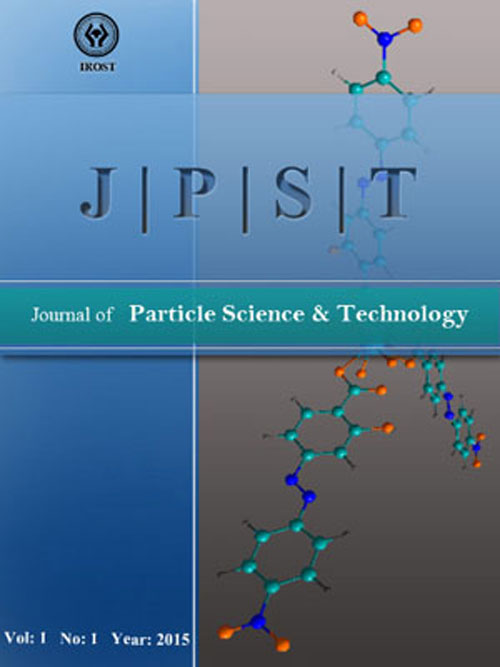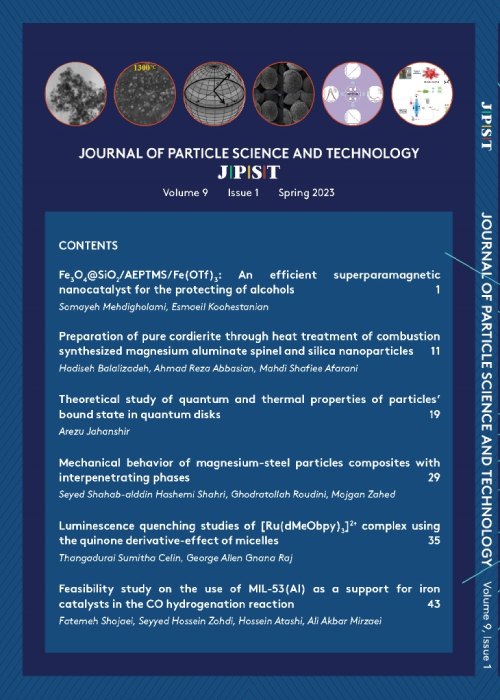فهرست مطالب

Journal of Particle Science and Technology
Volume:3 Issue: 3, Summer 2017
- تاریخ انتشار: 1396/06/30
- تعداد عناوین: 5
-
-
Pages 121-132Nanopore silicalite type membranes were prepared on the outer surface of a porous-mullite tube by in situ liquid phase hydrothermal synthesis. The hydrothermal crystallization was carried out under an autogenously pressure, at a static condition and temperature of 180 °C with tetrapropylammonium bromide (TPABr) as a template agent. The molar composition of the starting gel of silicalite zeolite membrane was: Na2O/SiO2=0.287-0.450, H2O/SiO2 = 8-15, TPABr/SiO2 = 0.01-0.04. The zeolites calcinations were carried out in air at 530 °C, to burn off the template (TPABr) within the zeolites. X-ray diffraction (XRD) patterns of the membranes consisted of peaks corresponding to the support and zeolite. The crystal species were characterized by XRD, and morphology of the supports subjected to crystallization was characterized by scanning electron microscopy (SEM). Performance of silicalite nanoporous membranes was studied for separation of water-unsymmetrical dimethylhydrazine (UDMH) mixtures using pervaporation (PV). Finally, a comprehensive steady state model was developed for the pervaporation of a water-UDMH mixture by COMSOL Multiphysics software version 5.2. The developed model was strongly capable of predicting the effect of various dimensional factors on concentration and velocity distribution within the membrane module. The best silicalite zeolite membranes had a water flux of 3.34 kg/m2.h at 27 °C. The best PV selectivity for Silicalite membranes obtained was 53.Keywords: Silicalite, Zeolite Membrane, Pervaporation, Water, UDMH separation, CFD simulation
-
Pages 133-143Fluid flow has a fundamental role in the performance of packed bed reactors. Some related issues, such as pressure drop, are strongly affected by porosity, so non-spherical particles are used in industry for enhancement or creation of the desired porosity. In this study, the effects of particle shape, size, and porosity of the bed on the hydrodynamics of packed beds are investigated with three non-spherical particles namely cylindrical, cone, and truncated cone in laminar and turbulent flow regimes (15 ≤ Re ≤ 2500) using computational fluid dynamics. According to results obtained from the simulations, it was observed that flow channelling occurs in the parts of the bed that are not well covered by particles, which is more near the wall. CFD simulations showed that the vortex flow around the cylindrical particles is more than the cone and truncated cone particles and are caused by increasing the pressure drop of fluid in the bed. It was also found that the particles creating less porosity in the bed, due to their shape, are caused by increasing the pressure drop of fluid. The numerical results showed good agreement with available empirical correlations in the literature.Keywords: Flow channeling, Non, spherical particles, Pressure drop, Porosity, vortex flow
-
Pages 145-154This paper presents an experimental design approach to the process parameter optimization for compocasting of A356-SiCp composites. Toward this end, parameters of stirring temperature, stirring time, stirring speed and SiC content were chosen and three levels of these parameters were considered. The D-optimal design of experiment (DODE) was employed for experimental design and analysis of results. In the experimental stage, different 20 µm-sized SiC particle contents (5, 10 and 15 vol %) were introduced into semisolid-state A356 aluminium alloy. Semisolid stirring was carried out at temperatures of 590, 600 and 610 °C with stirring speeds of 200, 400 and 600 rpm for 10, 20 and 30 min. The effect of these parameters on the distribution of the SiC particles within the matrix, represented by distribution factor (DF), was investigated. The smaller value of DF is indicative of the more uniform distribution of the SiC particles in the matrix. It was observed that the SiC particle content of 15 vol %, stirring temperature of 590 °C, stirring speed of 500 rpm, and stirring time of 30 min were the optimum parameter values producing the best distribution of the SiC particles in the matrix. The statistical test revealed that the main effect of the stirring temperature is the most significant factor.Keywords: A356, SiCp composite, Compocasting, Optimization, Modeling, D, optimal design of experiment
-
Pages 155-161Many research studies have been conducted on the liberation of locked minerals using a crusher and comparing this device with the other devices. This paper reviews the liberation of middle coal by different methods of crushing force. In the Tabas coal washing plant, particles of 0.5-50 mm size are processed through the heavy media method (using 3 Tri-flo separators) and particles of 0-0.5 mm size are processed using the flotation method (using 6 column flotation cells). A Tri-flo separator with a diameter of 700 mm and the capacity of 120 tons per hour is used for the cleaning of 6-50 mm raw coal particles. The study was conducted using a laboratory jaw crusher and a cage mill with a specific comminution ratio, both crushing forces were analyzed with the same distribution and mechanism of production of fines. In this study, grading and washability characteristics of a representative sample of middle product were reviewed and the dimensions of the ash were measured for each section. Intermediate product crushing using a laboratory jaw crusher and an industrial cage mill were conducted at up to 5 mm size and 50 percent of final speed. The amount of coal released after each section grading was determined by a sinking and floating test for size .5 mm and release analysis and ash testing for smaller dimensions of -0.5, these tests were conducted for each section product dimension. The results indicated that utilizing a cage mill is more effective than a laboratory jaw crusher, resulting in 11-percent more yield with 12 ash. The rate of fines produced through the laboratory jaw crusher is less than the industrial cage mill.Keywords: Comminution, Middle coal, Washability analysis, Cage mill, Jaw crusher
-
Pages 163-167Barite is an important additive material to increase the weight of excavation mud. It has been used extensively in the excavation mud industry. The barite particle sizes used in excavation mud is very important. There is a direct relationship between the amount on the sift of 200 and 325 mesh. By reducing particle sizes of the 200 and 325 mesh, the specific gravity of the barite power increased slightly. It could be concluded that increasing the size of the barite powder particle can reduce density, but this should be considered as a laboratorial error. Thus, granulation has a great influence on the viscosity of barite powder. According to previous studies dimensions below 325 mesh are very influential on viscosity. It can be said excavating companies consume more barite powder when the specific gravity of excavation mud is diminished because barite powder can enhance specific gravity but the viscosity goes up. There will be more problems in the excavation mud if viscosity increases.Keywords: Barite, excavating mud, mesh, specific weight, Viscosity


